Abstract
A bacteriophage typing scheme for differentiating Listeria isolates from dairy products and various other foodstuffs was developed. Sixteen selected phages isolated from both environmental sources and lysogenic strains were used for typing and, according to their lytic spectra, divided into four groups. Thus far, 41 distinct patterns of lysis were seen when this set was used in typing 57 defined reference strains, representing all five confirmed species and 16 serotypes in addition to 454 Listeria isolates of primarily foodborne origin. Overall, typability was 84.5%; i.e., a strain was lysed by at least one phage at 100x routine test dilution. Strains belonging to serovar 3 were mostly resistant to lysis by the phages employed. The results were highly reproducible, as determined in retyping trials several weeks later. Some phages isolated from environmental sources showed a wider lytic spectrum than did those isolated from lysogenic strains. In accordance with this, the phages were found in different clusters within a computer-generated linkage map. Species specificity and serovar specificity of the lytic reaction were not found. None of the phages was able to lyse strains of Listeria grayi, Listeria murrayi or Jonesia denitrificans. This phage typing system may provide important information for a means of recognizing and eliminating sources of contamination by Listeria spp. within dairy plant equipment.
Full text
PDF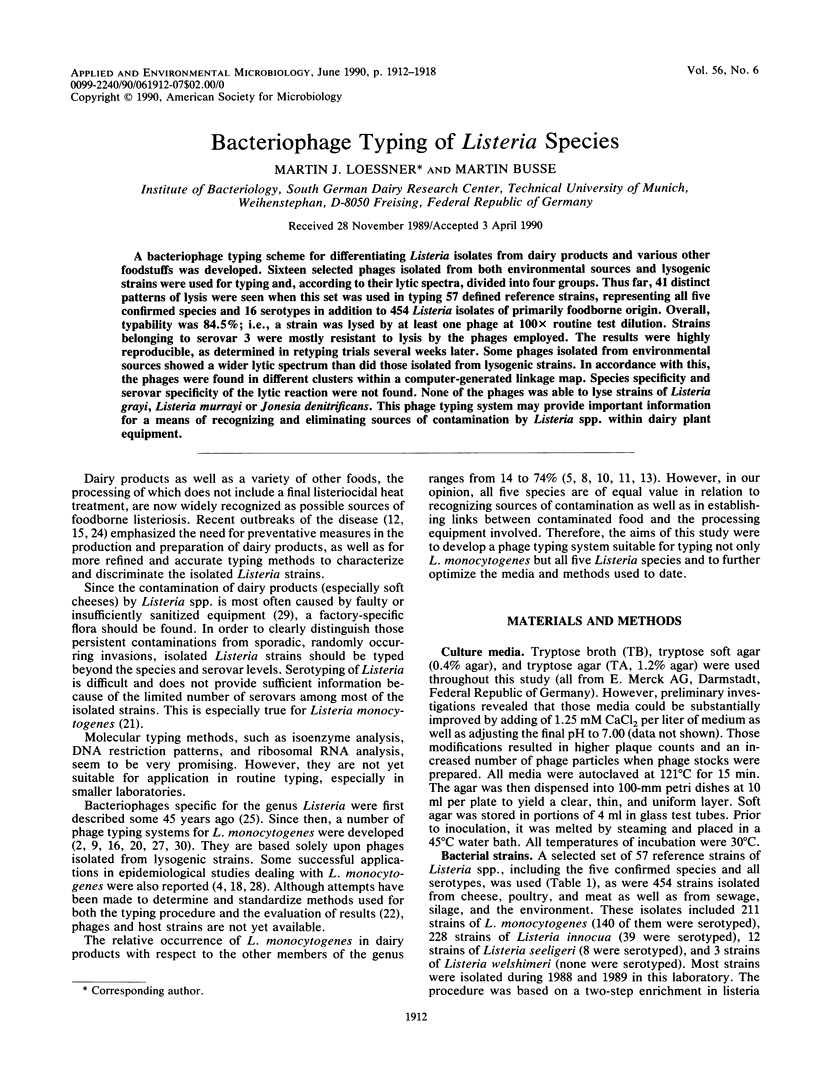
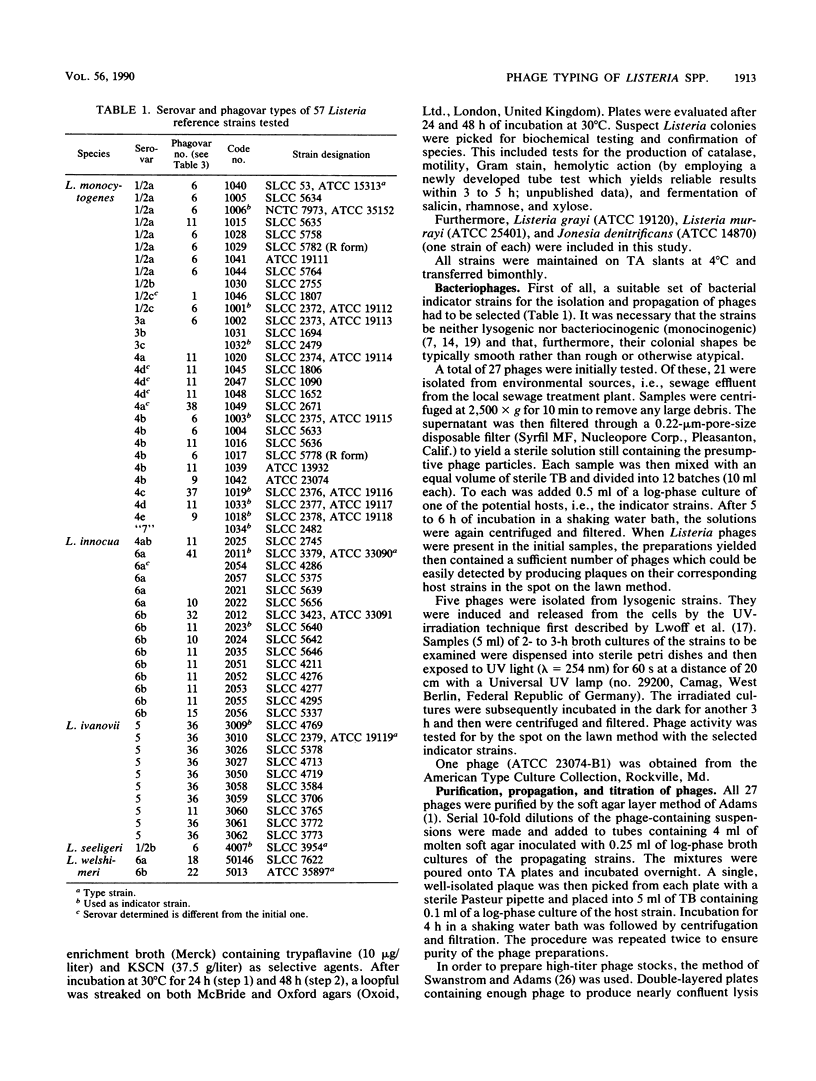
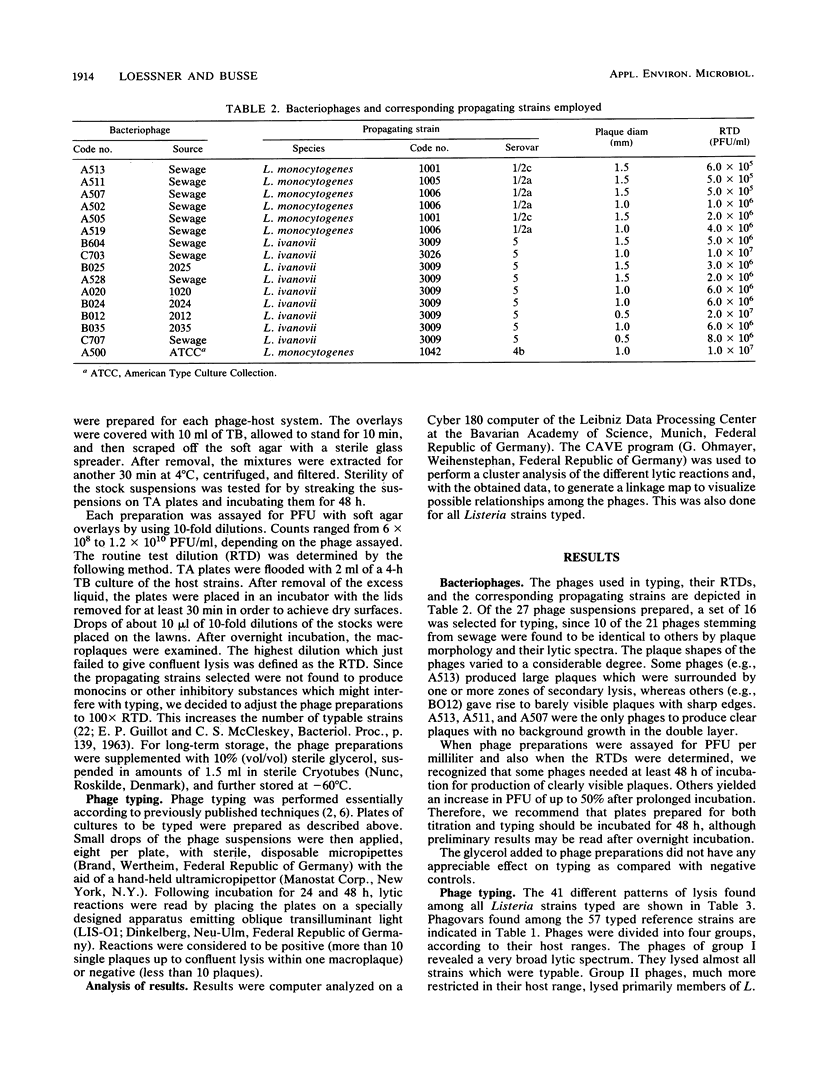
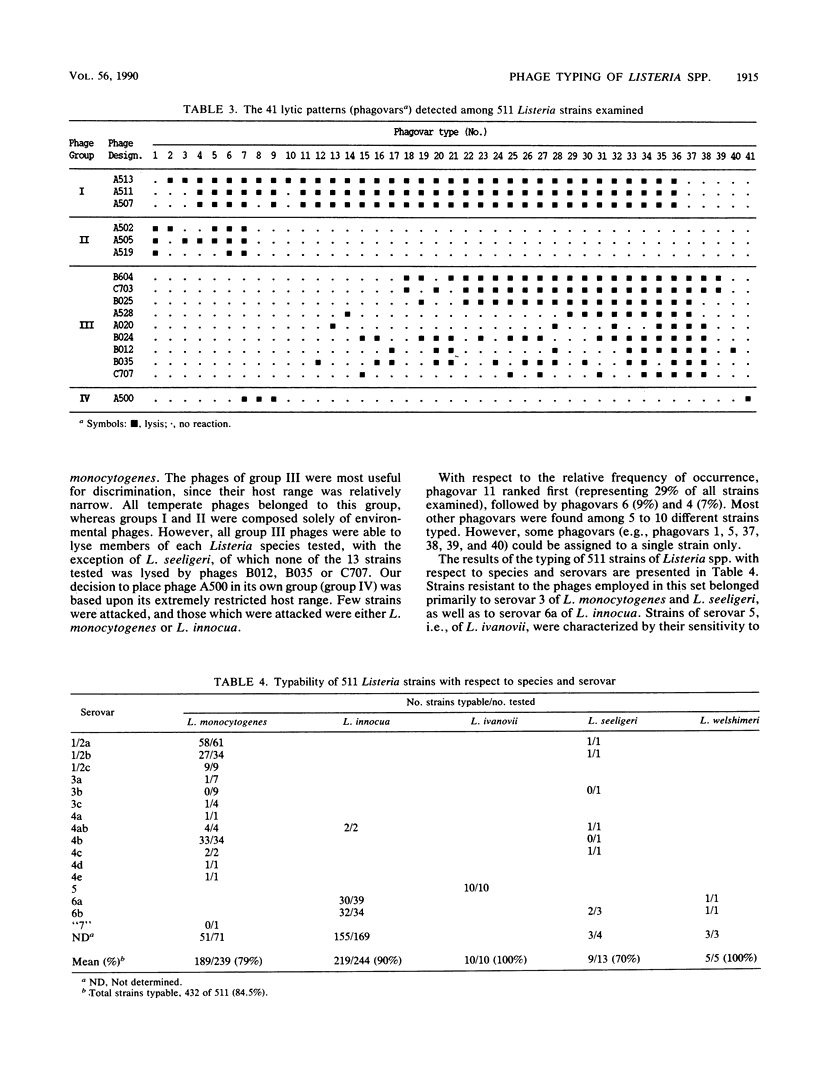
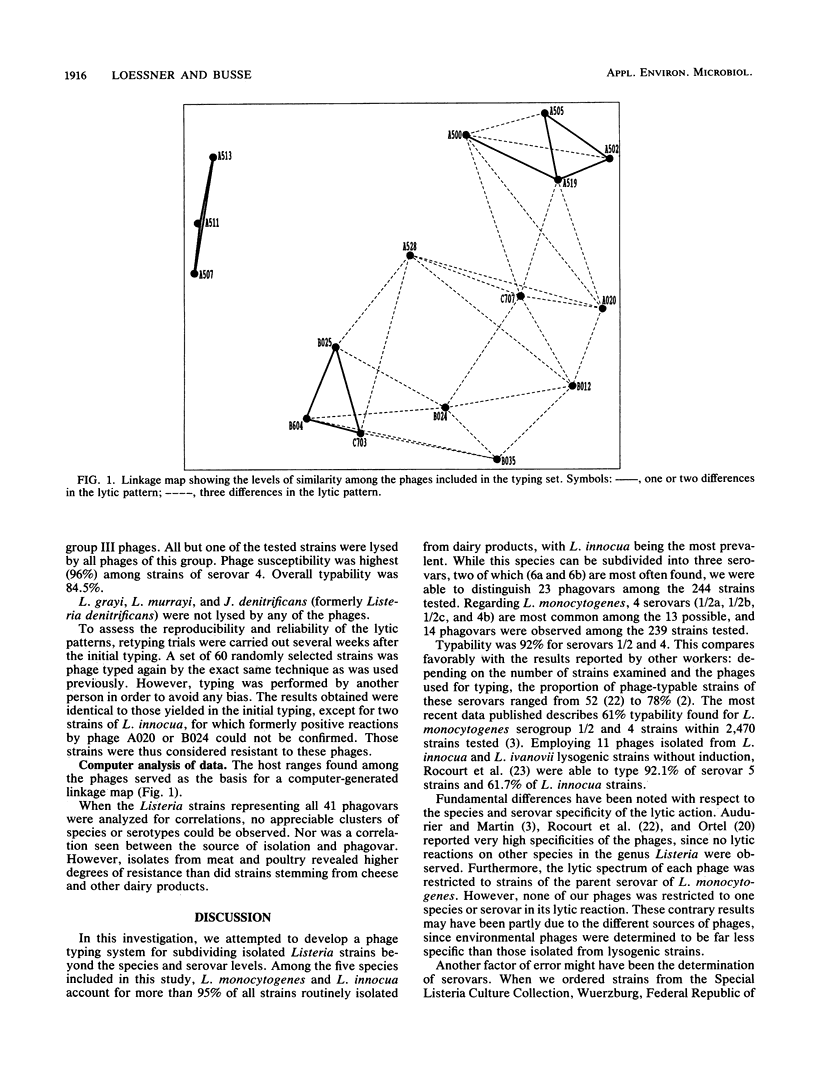
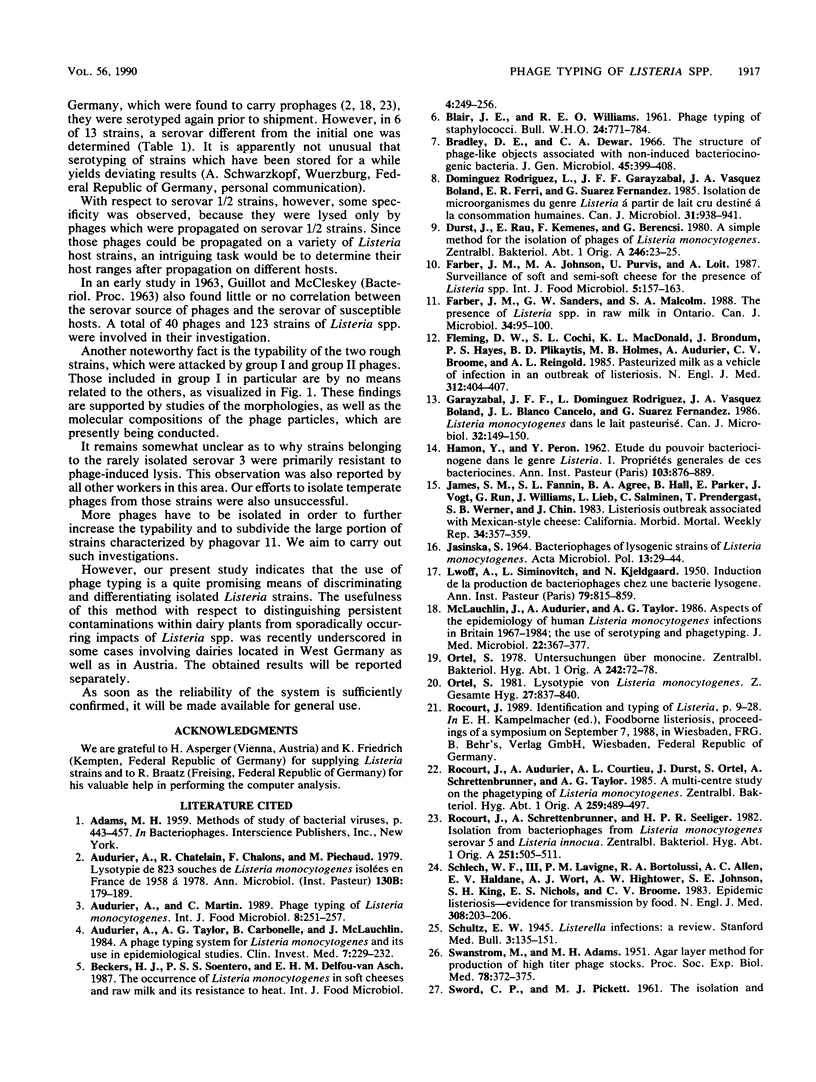
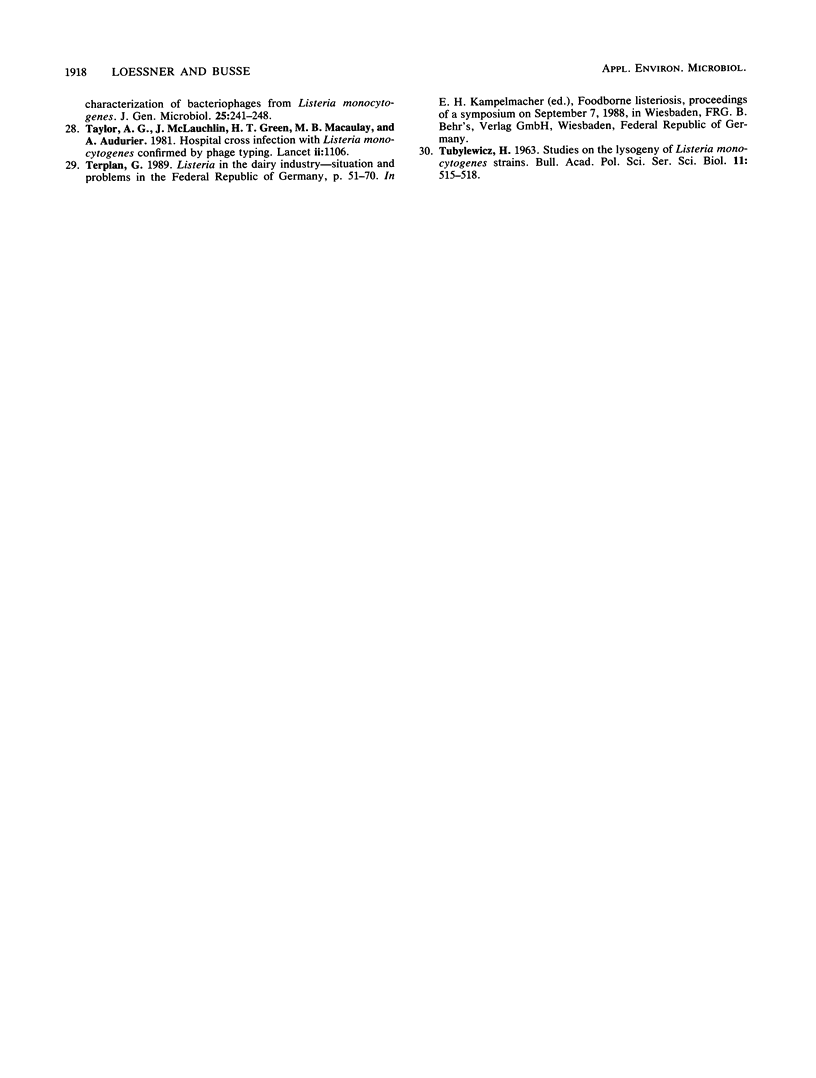
Selected References
These references are in PubMed. This may not be the complete list of references from this article.
- Audurier A., Chatelain R., Chalons F., Piéchaud M. Lysotypie de 823 souches de listeria monocytogenes isolées en France de 1958 à 1978. Ann Microbiol (Paris) 1979 Aug-Sep;130B(2):179–189. [PubMed] [Google Scholar]
- Audurier A., Martin C. Phage typing of Listeria monocytogenes. Int J Food Microbiol. 1989 Jun;8(3):251–257. doi: 10.1016/0168-1605(89)90022-6. [DOI] [PubMed] [Google Scholar]
- Audurier A., Taylor A. G., Carbonnelle B., McLauchlin J. A phage typing system for Listeria monocytogenes and its use in epidemiological studies. Clin Invest Med. 1984;7(4):229–232. [PubMed] [Google Scholar]
- Domínguez Rodriguez L., Fernández Garayzabal J. F., Vazquez Boland J. A., Rodriguez Ferri E., Suarez Fernández G. Isolation de micro-organismes du genre Listeria à partir de lait cru destiné à la consommation humaine. Can J Microbiol. 1985 Oct;31(10):938–941. [PubMed] [Google Scholar]
- Durst J., Rau E., Kemenes F., Berencsi G. A simple method for the isolation of phages from Listeria monocytogenes. Zentralbl Bakteriol A. 1980 Feb;246(1):23–25. [PubMed] [Google Scholar]
- Farber J. M., Sanders G. W., Malcolm S. A. The presence of Listeria spp. in raw milk in Ontario. Can J Microbiol. 1988 Feb;34(2):95–100. doi: 10.1139/m88-020. [DOI] [PubMed] [Google Scholar]
- Fernández Garayzábal J. F., Domínguez Rodríguez L., Vázquez Boland J. A., Blanco Cancelo J. L., Suárez Fernández G. Listeria monocytogenes dans le lait pasteurisé. Can J Microbiol. 1986 Feb;32(2):149–150. [PubMed] [Google Scholar]
- Fleming D. W., Cochi S. L., MacDonald K. L., Brondum J., Hayes P. S., Plikaytis B. D., Holmes M. B., Audurier A., Broome C. V., Reingold A. L. Pasteurized milk as a vehicle of infection in an outbreak of listeriosis. N Engl J Med. 1985 Feb 14;312(7):404–407. doi: 10.1056/NEJM198502143120704. [DOI] [PubMed] [Google Scholar]
- JASINSKA S. BACTERIOPHAGES OF LYSOGENIC STRAINS OF LISTERIA MONOCYTOGENES. Acta Microbiol Pol. 1964;13:29–43. [PubMed] [Google Scholar]
- LWOFF A., SIMINOVITCH L., KJELDGAARD N. Induction de la production de bacteriophages chez une bactérie lysogène. Ann Inst Pasteur (Paris) 1950 Dec;79(6):815–859. [PubMed] [Google Scholar]
- McLauchlin J., Audurier A., Taylor A. G. Aspects of the epidemiology of human Listeria monocytogenes infections in Britain 1967-1984; the use of serotyping and phage typing. J Med Microbiol. 1986 Dec;22(4):367–377. doi: 10.1099/00222615-22-4-367. [DOI] [PubMed] [Google Scholar]
- Ortel S. Lysotypie von Listeria monocytogenes. Z Gesamte Hyg. 1981 Nov;27(11):837–840. [PubMed] [Google Scholar]
- Ortel S. Untersuchungen über Monocine. Zentralbl Bakteriol Orig A. 1978 Nov;242(1):72–78. [PubMed] [Google Scholar]
- Rocourt J., Audurier A., Courtieu A. L., Durst J., Ortel S., Schrettenbrunner A., Taylor A. G. A multi-centre study on the phage typing of Listeria monocytogenes. Zentralbl Bakteriol Mikrobiol Hyg A. 1985 Jul;259(4):489–497. doi: 10.1016/s0176-6724(85)80081-x. [DOI] [PubMed] [Google Scholar]
- Rocourt J., Schrettenbrunner A., Seeliger H. P. Isolation of bacteriophages from Listeria monocytogenes Serovar 5 and Listeria innocua. Zentralbl Bakteriol Mikrobiol Hyg A. 1982 Apr;251(4):505–511. [PubMed] [Google Scholar]
- SWANSTROM M., ADAMS M. H. Agar layer method for production of high titer phage stocks. Proc Soc Exp Biol Med. 1951 Nov;78(2):372–375. doi: 10.3181/00379727-78-19076. [DOI] [PubMed] [Google Scholar]
- SWORD C. P., PICKETT M. J. The isolation and characterization of bacteriophages from Listeria monocytogenes. J Gen Microbiol. 1961 Jun;25:241–248. doi: 10.1099/00221287-25-2-241. [DOI] [PubMed] [Google Scholar]
- Schlech W. F., 3rd, Lavigne P. M., Bortolussi R. A., Allen A. C., Haldane E. V., Wort A. J., Hightower A. W., Johnson S. E., King S. H., Nicholls E. S. Epidemic listeriosis--evidence for transmission by food. N Engl J Med. 1983 Jan 27;308(4):203–206. doi: 10.1056/NEJM198301273080407. [DOI] [PubMed] [Google Scholar]
- Taylor A. G., McLauchlin J., Green H. T., Macauley M. B., Audurier A. Hospital cross-infection with Listeria monocytogenes confirmed by phage-typing. Lancet. 1981 Nov 14;2(8255):1106–1106. doi: 10.1016/s0140-6736(81)91298-8. [DOI] [PubMed] [Google Scholar]


